Picture strolling through a store, your eyes scanning for the perfect cosmetics find. What grabs your attention first? Often, it’s the label.
Cosmetic labels are one of the most essential components of cosmetic packaging. They are the initial link between your product and potential buyers, conveying essential details like product names, ingredients, usage instructions, and brand identity, all in a small space.
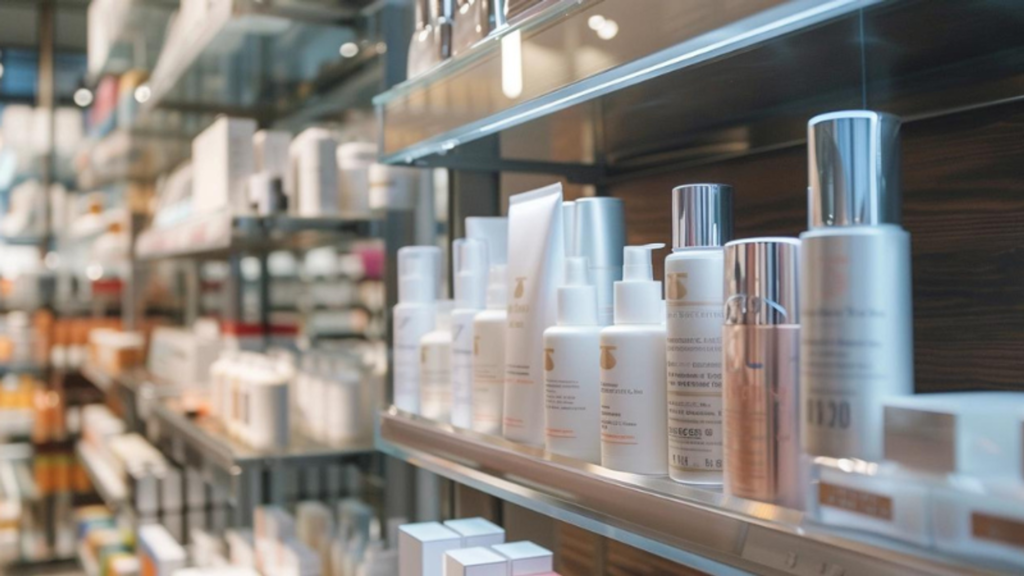 Skincare Products and Cosmetics in Store
Skincare Products and Cosmetics in StoreBut labels go beyond information. They are the storytellers of your brand, the silent ambassadors who speak volumes about your product’s quality, safety, and allure.
As we uncover the secrets of successful cosmetic labels in this post, remember their pivotal role. From meeting cosmetic labeling requirements to design choices, we’ll explore how these details can transform your own label cosmetics from ordinary to extraordinary.
As a cosmetic supplier, understanding the essentials of cosmetic packaging labeling is crucial.
Regulatory Requirements: Navigating Compliance
Firstly, let’s talk about cosmetic labeling requirements. These are the rules and regulations set by governing bodies that ensure your product meets safety standards.
It’s necessary to understand and adhere to these requirements to avoid any legal issues and ensure customer safety.
 Cosmetic Labels to be Compliant
Cosmetic Labels to be CompliantAn effective cosmetic label is a powerful tool for transparency.
Consumers expect certain key pieces of information to be readily available. These details build trust with consumers, giving them confidence in the authenticity and quality of your product.
Product Name: Concise and Clear
The first thing that catches your eye on a label is, of course, the product name. It should be clear, concise, and representative of the item inside.
A catchy name can draw attention, but clarity is paramount.
Net Weight: Idea of What’s Inside
Knowing the quantity of the product is essential for consumers to understand its value and usage.
Whether it’s in milliliters, grams, or ounces, the net weight gives a clear idea of what’s inside.
One of the most scrutinized sections of cosmetic labels is the ingredients list. This is where consumers look to understand what they are putting on their skin.
It’s vital for consumers who may have allergies or sensitivities, allowing them to make informed decisions.
Usage Instructions: Clear and Concise Guidance
Clear and concise usage instructions are essential.
This section guides your customers on how to use the product effectively for optimal results. Whether it’s application techniques or frequency of use, make sure it’s easy to understand.
Expiry Date: Ensuring Product Freshness
Lastly, the expiry date is a critical piece of information. It informs consumers about the shelf life of the product and when it’s best to use it. This helps maintain product effectiveness and ensures customer safety.
For more details, please refer to FDA Cosmetic Labeling Guidance.
Designing Eye-Catching Labels
Designing eye-catching labels for cosmetic packaging requires a thoughtful blend of visual appeal, effective design elements, and sustainable materials.
If designed well, even private label cosmetics that are new to the market can stand out and succeed in the marketplace, such as the ones we now know as Kylie Cosmetics and ColourPop.
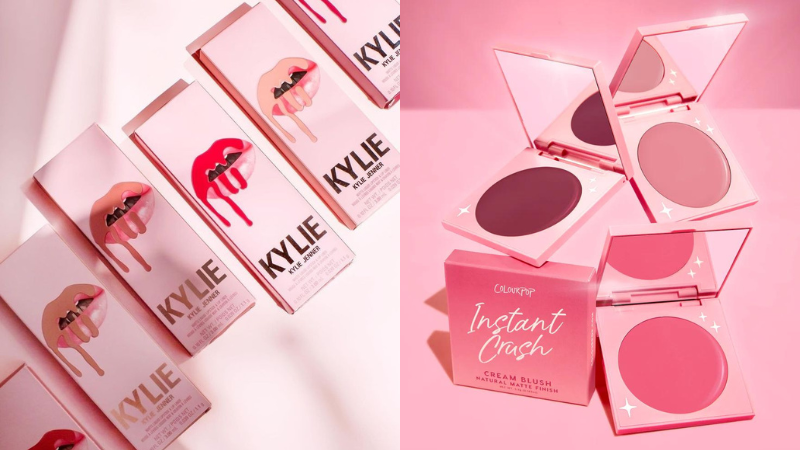 Kylie Cosmetic and ColourPop (Image Source: Pinterest)
Kylie Cosmetic and ColourPop (Image Source: Pinterest)Importance of Visual Appeal: Catching the Eye
Your label is often the first point of contact with customers.
A visually appealing label can draw attention and make a lasting impression on potential buyers. It’s your chance to stand out on crowded shelves and convey your brand’s identity.
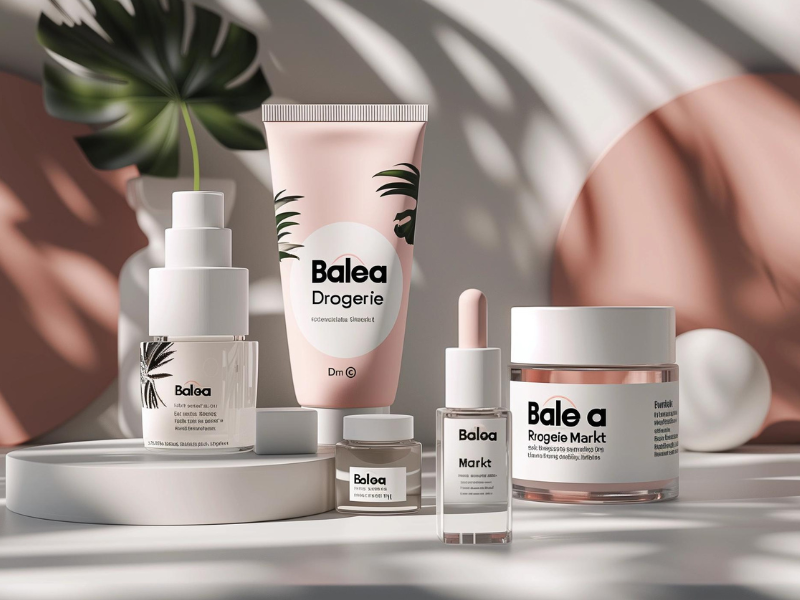 A Cosmetic Set with Attractive Labels
A Cosmetic Set with Attractive LabelsElements of Effective Label Design: Crafting the Perfect Look
The main elements that make up an effective label design usually include color psychology, fonts and typography, graphics, and images.
Color psychology plays a significant role – different colors evoke different emotions and associations.
 Important Cosmetic Label Design Element – Color
Important Cosmetic Label Design Element – ColorFonts and typography also contribute to readability and brand personality.
And of course, graphics and images are powerful tools to communicate your product’s benefits and attract attention.
Materials Matter: Choosing the Right Substrate
The choice of label material can significantly impact the overall look and feel of your product. Different materials offer varying levels of durability, texture, and finish.
Consider the environmental impact too – sustainability in cosmetic packaging labeling is a growing concern. Opting for eco-friendly label options can align with consumer preferences and demonstrate your commitment to the environment.
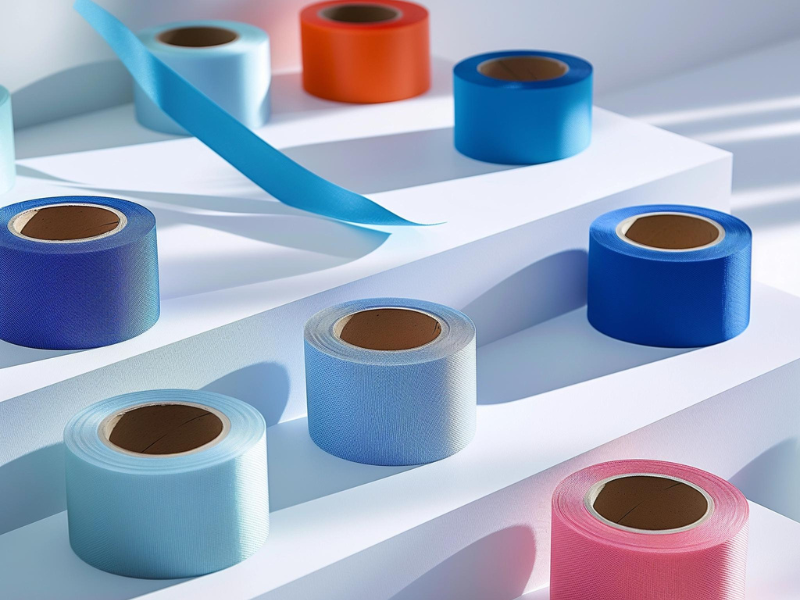 Label Material
Label MaterialBy understanding these factors, you can create labels that not only stand out on shelves but also communicate your brand’s values and resonate with customers.
Innovative Labeling Techniques
Innovative labeling techniques have greatly influenced and inspired the design of cosmetic product labels.
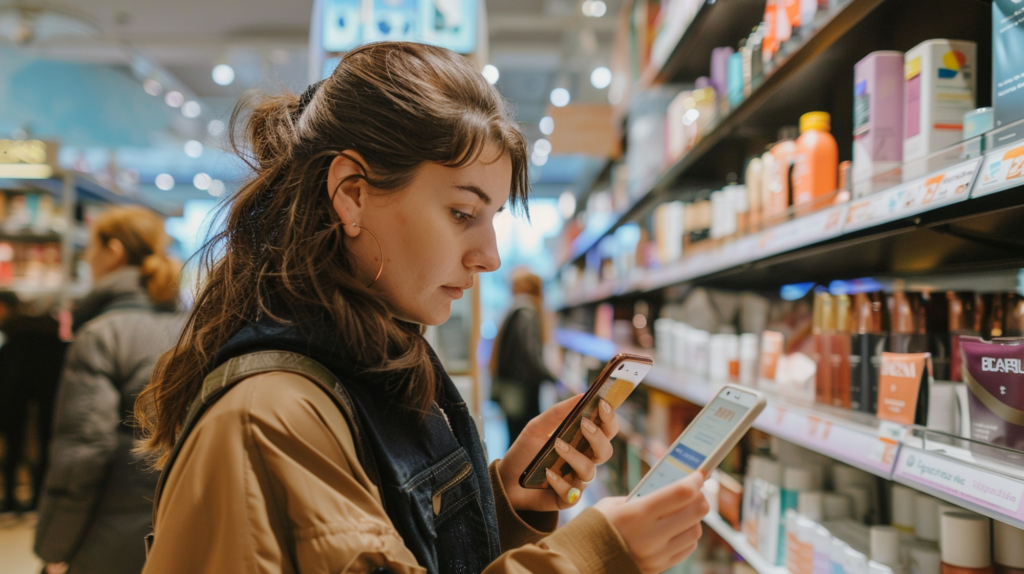 Customers Scanning the Labels on Cosmetic Packaging
Customers Scanning the Labels on Cosmetic PackagingInteractive Labels: Engaging with Touch
Interactive labels are revolutionizing how customers interact with products. They respond to touch, changing color or texture, offering a tactile experience.
Imagine a label that reacts to the environment, creating an unforgettable sensory connection.
Smart Packaging Technology: Elevating User Experience
Smart packaging goes beyond traditional labels, incorporating technology like sensors and microchips. These labels provide real-time information on product usage, expiration dates, and personalized recommendations.
By connecting with consumers’ devices, smart packaging enhances user experience and fosters brand loyalty.
Near Field Communication (NFC) tags are tiny chips embedded in labels. With a simple tap of a smartphone, customers access detailed product information, tutorials, or promotions.
NFC tags offer convenience and instant gratification, bridging the gap between physical products and digital content.
QR Codes: Quick and Convenient
QR codes have become a staple in labeling, offering a quick way to access additional information.
By scanning a QR code, customers unlock a treasure trove of details – from ingredient lists to demonstration videos. QR codes provide a seamless way to connect offline and online experiences.
You can imagine the emergence of these innovations is transforming cosmetic packaging labeling, offering new ways to engage customers and differentiate products.
Storytelling Through Labels
So, how do labels function in cosmetic packaging? Why should cosmetic suppliers prioritize label design?
By crafting labels that tell a compelling story and convey brand values, brands can forge deeper connections with customers.
 Storytelling Through Labels
Storytelling Through LabelsBrand Storytelling on Packaging: Connecting with Customers
Packaging is more than just a container; it’s a storytelling platform. Brands can use labels to narrate their journey, values, and mission.
From the choice of colors to the design elements, each aspect of a label can speak volumes about the brand’s identity. Customers are drawn to stories that resonate with them, creating a strong emotional connection.
Using Labels to Convey Brand Values: A Visual Representation
Labels serve as a visual representation of a brand’s values. Whether it’s a commitment to sustainability, cruelty-free products, or inclusivity, these values can be communicated through label design.
Customers appreciate transparency and authenticity, and labels that reflect a brand’s values can build trust and loyalty.
These are what an efficacious label means. Let’s embrace the art of storytelling through cosmetic labels for a more meaningful brand-consumer relationship.
Label Testing and Iteration
Label testing and iteration is a crucial process for skincare and cosmetics suppliers.
By continuously improving labels through testing and feedback, you enhance brand credibility and customer satisfaction.
Importance of Testing Labels: A Vital Step
Testing labels ensures they resonate with your target audience. It helps identify potential issues with readability, design, or information accuracy. By testing, you can catch errors early on and refine your labels for maximum impact.
Feedback Loop for Label Improvement: Continuous Refinement
Creating a feedback loop allows for ongoing label improvement. Gather feedback from customers, distributors, and industry experts. Use this input to refine labels, ensuring they meet regulatory requirements and customer preferences.
Avoiding Common Labeling Mistakes
As cosmetic suppliers, we know the pivotal role that cosmetic product labels play in our products’ success. Yet, amidst the whirlwind of production, it’s easy to overlook some crucial aspects. Let’s delve into common pitfalls and how to sidestep them.
Common Pitfalls to Avoid
Inaccurate ingredient lists, misleading claims, and inconsistent branding can tarnish a product’s reputation. Transparency is key. Ensure your labels comply with regulations and convey accurate information to consumers.
Tips for Labeling Compliance and Accuracy
- Double-check all ingredient lists for accuracy.
- Ensure claims align with the product’s actual benefits.
- Maintain brand consistency across all labels.
Remember, a meticulously crafted label not only informs but also builds trust with your customers. Let’s strive for accuracy and compliance in every detail.
Future Trends in Cosmetic Labeling
The future of cosmetic packaging labeling is upon us, with innovative trends paving the way for exciting changes.
Let’s explore two key trends that are set to revolutionize cosmetic packaging labelling.
Augmented Reality Labels
Imagine scanning a cosmetic label with your phone and instantly seeing product demos or virtual makeup trials.
Augmented reality labels are bridging the gap between online and offline shopping, offering an immersive experience for consumers.
Customization and Personalization Trends
Personalized skincare routines are on the rise, and custom cosmetic labels are following suit. From customizable color schemes to personalized ingredient lists, brands are catering to individual preferences like never before.
As skincare and cosmetic suppliers, embracing these trends can set your products apart in a competitive market. Stay ahead of the curve by exploring augmented reality labels and customization options for a truly engaging consumer experience.
Conclusion
Mastering the art of cosmetic labels involves understanding their critical role in product success.
From meeting cosmetic labeling requirements to captivating consumers with eye-catching designs, each element is crucial. Embrace innovative techniques like interactive labels and AR technology to set your brand apart.
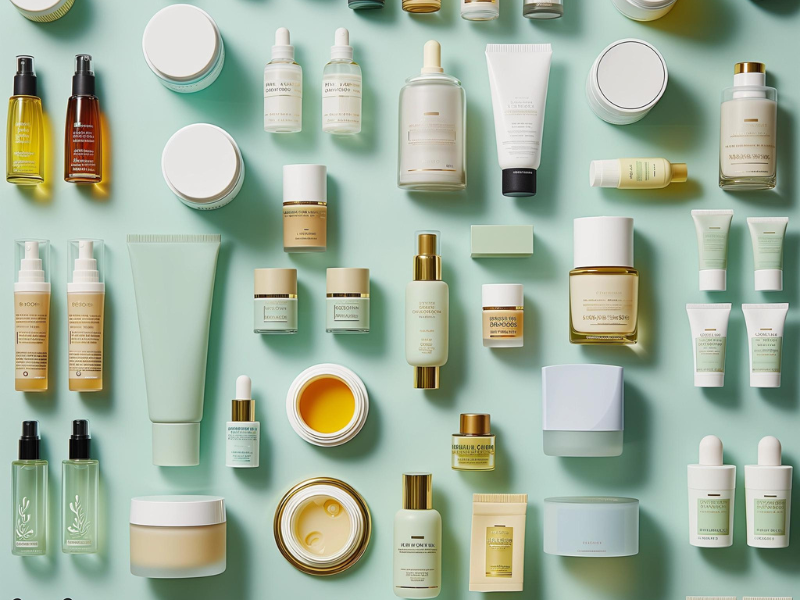 Diverse Cosmetic Packaging Labels
Diverse Cosmetic Packaging LabelsRemember, cosmetic labels tell a story and convey brand values, creating a lasting impression.
Avoid common pitfalls and stay updated on future trends to create labels that truly shine in the competitive cosmetic market.
Looking for skincare and cosmetic packaging to match your labels, please contact us to learn more!